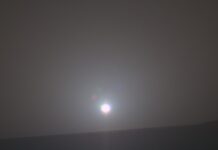This video shows the moment an unusual optical phenomenon showed up in the sky. The ring around the sun that bemused onlookers is called a circular halo or a 22° halo.
Scientists say that this natural event is produced by light interacting with ice crystals suspended in the atmosphere. Light is reflected and refracted by the ice crystals which behave like prisms and mirrors. These ice crystals are typically suspended in cirrus or cirrostratus clouds in the upper troposphere.
Even though this is one of the most common types of halo, the exact shape and orientation of the responsible ice crystals are a topic of debate. Hexagonal, randomly oriented columns are usually put forward as the most likely candidate. However, the flaw of this explanation is the fact that the aerodynamic properties of such crystals leads them to be oriented horizontally rather than randomly. Alternative theories include the involvement of clusters of bullet-shaped ice columns.
There is a wavelength-dependent variation in refraction which causes the inner edge of the circle to be reddish while the outer edge is bluish.
The ice crystals in the clouds all deviate the light similarly, but only the ones from the specific ring at 22 degrees contribute to the effect for an observer at a set distance. As no light is refracted at angles smaller than 22°, the sky can be darker inside the halo.
In folklore and in the past, it was believed that these halos warn of incoming storms. This is somewhat true as the clouds that cause them often signify an approaching frontal system.
















